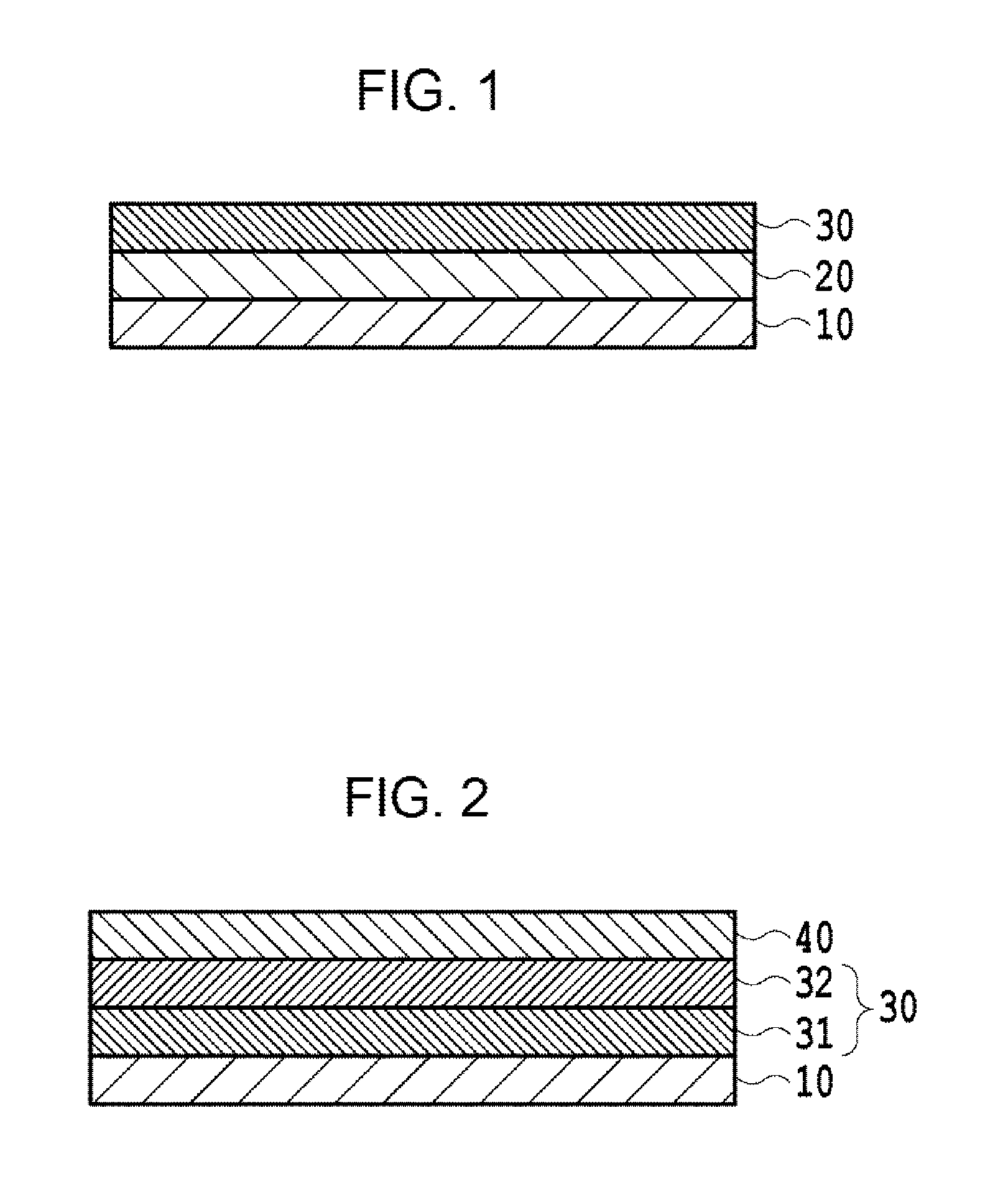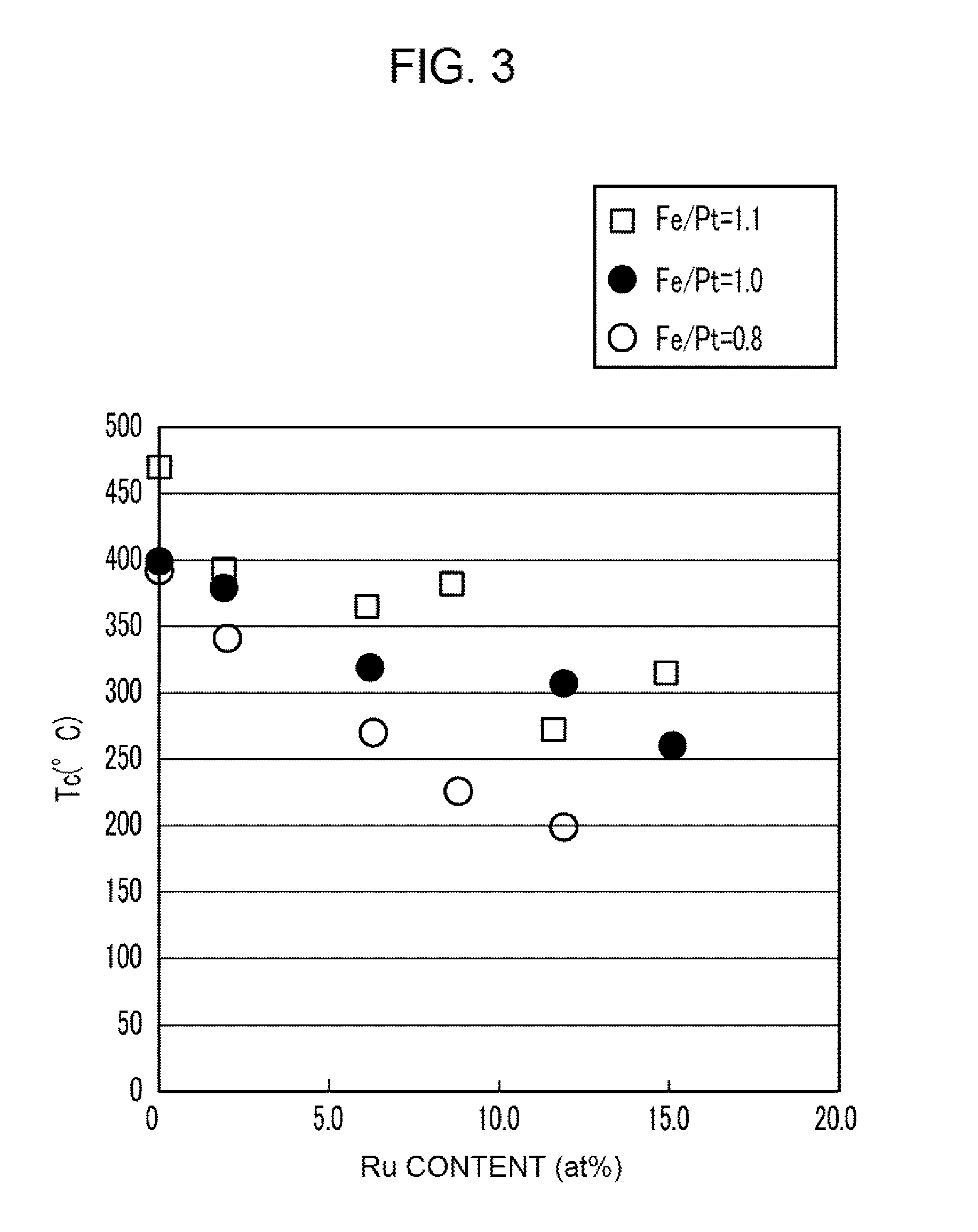Magnetic recording medium
a recording medium and magnetic technology, applied in the field of magnetic recording mediums, can solve the problems of reduced thermal stability of written magnetization (signal), difficult writing of magnetization (signal), and limitations on heating means that can be used, and achieve the effect of high heat stability of written magnetization
- Summary
- Abstract
- Description
- Claims
- Application Information
AI Technical Summary
Benefits of technology
Problems solved by technology
Method used
Image
Examples
example 1
[0059]A nonmagnetic substrate 10 was prepared by cleaning a (001) MgO single-crystal substrate that had a smooth, flat surface. After cleaning, the nonmagnetic substrate 10 was introduced into a sputtering apparatus. After the nonmagnetic substrate 10 had been heated to 350° C., a Pt seed layer 20 with a film thickness of 20 nm was formed by RF magnetron sputtering in Ar gas at a pressure of 0.44 Pa using a Pt target.
[0060]The nonmagnetic substrate 10 bearing the seed layer 20 was then heated to 350° C. and an FePtRu magnetic recording layer 30 with a film thickness of 10 nm was formed by RF magnetron sputtering in Ar gas at a pressure of 0.60 Pa using an FePt target and an Ru target, thus yielding a magnetic recording medium having the structure shown in FIG. 1. The Fe and Pt contents in the magnetic recording layer were adjusted using a target with an Fe / Pt ratio of 1.1, a target with an Fe / Pt ratio of 1.0, and a target with an Fe / Pt ratio of 0.8 for the FePt target. In addition, ...
example 2
[0070]A nonmagnetic substrate 10 was prepared by cleaning a (001) MgO single-crystal substrate that had a smooth, flat surface. After cleaning, the nonmagnetic substrate 10 was introduced into a sputtering apparatus.
[0071]After the nonmagnetic substrate 10 had been heated to 430° C., an FePt—C first magnetic layer 31 having a granular structure and a film thickness of 2 nm was formed by DC magnetron sputtering in Ar gas at a pressure of 1.5 Pa using an FePt target and a C target. The power applied to the FePt target was 40 W, and the power applied to the C target was 232 W. The Fe content and Pt content in the magnetic crystal grains in the resulting first magnetic layer 31 was 49 at % and 51 at %, respectively, with reference to the total number of atoms in the magnetic crystal grains. The content of the C constituting the nonmagnetic grain boundary was 40 volume % with reference to the volume of the first magnetic layer 31.
[0072]The nonmagnetic substrate 10 bearing the first magne...
example 3
[0076]Magnetic recording media were obtained by repeating the procedure in Example 2, but in this case changing the amount of Ru addition by adjusting the power applied to each of the targets during formation of the second magnetic layer 32. The contents of the Fe, Pt, and Ru in the magnetic crystal grains of the resulting second magnetic layers 32 of this example were 46 at %, 48 at %, and 6 at %, respectively, with reference to the total number of atoms in the magnetic crystal grains.
[0077]The saturation magnetization Ms and magnetic anisotropy constant Ku were measured on the obtained magnetic recording layers using the same procedures as in Example 2 and the net magnetic anisotropy constant Ku_grain was calculated for the magnetic crystal grains. The compositions of the magnetic recording layers and the results of the measurements are given in Table 5.
PUM
| Property | Measurement | Unit |
|---|---|---|
| temperature | aaaaa | aaaaa |
| temperature | aaaaa | aaaaa |
| thickness | aaaaa | aaaaa |
Abstract
Description
Claims
Application Information
 Login to View More
Login to View More - R&D
- Intellectual Property
- Life Sciences
- Materials
- Tech Scout
- Unparalleled Data Quality
- Higher Quality Content
- 60% Fewer Hallucinations
Browse by: Latest US Patents, China's latest patents, Technical Efficacy Thesaurus, Application Domain, Technology Topic, Popular Technical Reports.
© 2025 PatSnap. All rights reserved.Legal|Privacy policy|Modern Slavery Act Transparency Statement|Sitemap|About US| Contact US: help@patsnap.com



